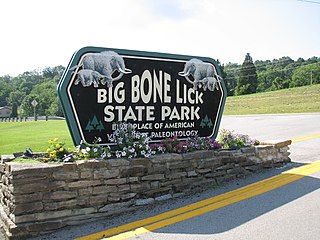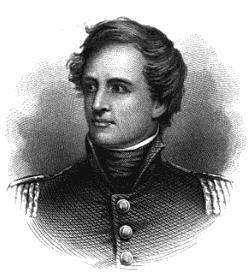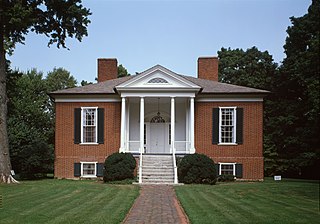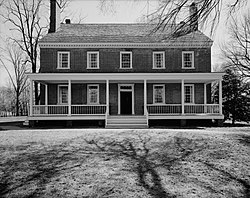
Mammoth Cave National Park is a national park in south-central Kentucky, encompassing portions of Mammoth Cave, the longest cave system known in the world. The park's 52,830 acres (21,380 ha) are located primarily in Edmonson County, with small areas extending eastward into Hart and Barren counties. The Green River runs through the park, with a tributary called the Nolin River feeding into the Green just inside the park.

Big Bone Lick State Park is located at Big Bone in Boone County, Kentucky. The name of the park comes from the Pleistocene megafauna fossils found there. Mammoths are believed to have been drawn to this location by a salt lick deposited around the sulfur springs. Other animals including forms of bison, caribou, deer, elk, horse, mastodon, moose, musk ox, peccary, ground sloths, wolves, black bears, stag moose, saber-toothed cats, and possibly tapir also grazed the vegetation and salty earth around the springs that the animals relied on for their diet.

Stephen Bishop was an American cave explorer and self-taught geologist known for being one of the first people to explore and map Mammoth Cave in the U.S. state of Kentucky. Mammoth Cave is regarded as the longest cave system in the world and Bishop's map of the cave, hand-drawn from memory off-site in 1842, was included in a book published in 1844. It was regarded as the authoritative map of the cave system for over four decades. Bishop was enslaved and worked as a guide at Mammoth for approximately 19 years. He was freed by manumission the year before his death.

George Croghan was an American soldier who was a recipient of the Congressional Gold Medal.

Cave Hill Cemetery is a 296-acre (1.20 km2) Victorian era National Cemetery and arboretum located at Louisville, Kentucky. Its main entrance is on Baxter Avenue and there is a secondary one on Grinstead Drive. It is the largest cemetery by area and number of burials in Louisville.

Falls of the Ohio State Park is a state park in the U.S. state of Indiana. It is located on the banks of the Ohio River at Clarksville, Indiana, across from Louisville, Kentucky. The park is part of the Falls of the Ohio National Wildlife Conservation Area. The exposed fossil beds of the Jeffersonville Limestone dated from the Devonian period are the main feature of the park, attracting about 160,000 visitors annually. The Falls was the site where Lewis and Clark met for the Lewis and Clark Expedition at George Rogers Clark's cabin.

Farmington, an 18-acre (7.3 ha) historic site in Louisville, Kentucky, was once the center of a hemp plantation owned by John and Lucy Speed. The 14-room, Federal-style brick plantation house was possibly based on a design by Thomas Jefferson and has several Jeffersonian architectural features. As many as 64 African Americans were enslaved by the Speed family at Farmington.

This is a list of properties and historic districts in Kentucky that are listed on the National Register of Historic Places. There are listings in all of Kentucky's 120 counties.

The Zachary Taylor House, also known as Springfield, was the boyhood home of the 12th president of the United States, Zachary Taylor. Located in what is now a residential area of Louisville, Kentucky, Taylor lived there from 1785 to 1808, held his marriage there in 1810, and returned there periodically the rest of his life.

Blackacre State Nature Preserve is a 271-acre (110 ha) nature preserve and historic homestead in Louisville, Kentucky. The preserve features rolling fields, streams, forests, and a homestead dating back to the 18th century. For visitors, the preserve features several farm animals including horses, goats, and cows, hiking trails, and a visitor's center in the 1844-built Presley Tyler home. Since 1981, it has been used by the Jefferson County Public Schools as the site of a continuing environmental education program. About 10,000 students visit the outdoor classroom each year.

The table below includes sites listed on the National Register of Historic Places (NRHP) in Jefferson County, Kentucky except those in the following neighborhoods/districts of Louisville: Anchorage, Downtown, The Highlands, Old Louisville, Portland and the West End. Links to tables of listings in these other areas are provided below.
Dr. John Croghan was an American medical doctor and slave owner who helped establish the United States Marine Hospital of Louisville and organized some tuberculosis medical experiments and tours for Mammoth Cave, in Kentucky (U.S.) during 1839–1849.
The Locust Grove Stakes is a Grade III American Thoroughbred horse race for fillies and mares, age three and older, over a distance of 1+1⁄16 miles held annually in September during the early fall meeting at Churchill Downs in Louisville, Kentucky. The current purse is $400,000.
The history of the Irish in Louisville, Kentucky, USA dates to the founding of the city. There were two major waves of Irish influence on Louisville - the Scots-Irish in the late 18th century, and those who escaped from the Great Famine of the 1840s.

This is a list of the National Register of Historic Places listings in Shelby County, Kentucky.

This is a list of the National Register of Historic Places listings in Edmonson County, Kentucky.

This is a list of the National Register of Historic Places listings in Bullitt County, Kentucky.
Belknap is an urban neighborhood three and a half miles east of downtown Louisville, Kentucky, USA. The neighborhood is bound by Bardstown Road, Douglass Boulevard, Dundee Road and Newburg Road. It is part of a larger area of Louisville called the Highlands. Belknap is often described as the neighborhood in the heart of The Highlands.


























